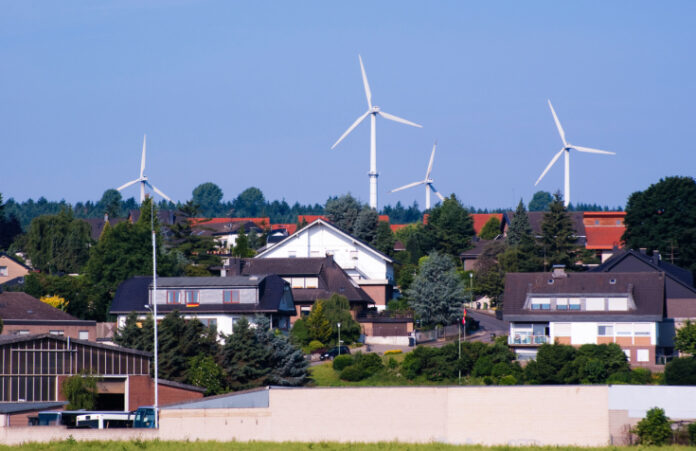In recent years, fears that electricity generation from fossil fuels contributes to climate change have encouraged governments around the world to push the installation of intermittent electricity generation projects including Industrial Wind Turbines (IWT’s).
NIMBYs Takes on Big Wind Over Health Concerns
But Whoa, Nelly! The Not-In-My-Backyard (NIMBYs) movement around the globe from Germany to Australia, California, New York, and Massachusetts are speaking loudly, and acting, to put a halt to the invasion of noisy industrial wind facilities in their backyards. Following numerous reports on wind turbine noise from disparate locations, spanning, for instance, Maryland, Canada, and France, NIMBYs are becoming energized (no pun intended).
In one case, the National Center for Biotechnology Information located in Bethesda, Maryland (NCBI) reported that industrial wind turbine noise amplitude modulation, audible low-frequency noise, tonal noise, infrasound, and lack of nighttime abatement have been identified as plausible noise characteristics that could cause annoyance and other health effects. Documented symptoms reported by individuals exposed to wind turbines, include: Sleep disturbance, Headaches, Ear Pressure, Dizziness, Vertigo, Nausea, Visual blurring, Irritability, Problems with concentration and memory, and Panic episodes associated with sensations of internal pulsation or quivering when awake or asleep.
And although the Green Energy Act (GEA) of Ontario, Canada may have been well-intended, a recent analysis published by the Fraser Institute, Environmental and Economic Consequences of Ontario’s Green Energy Act, demonstrates the GEA has had disastrous impacts on Ontario’s energy rates and is going to seriously threaten economic competitiveness for the manufacturing and mining sectors.
The French Academy of Medicine has declared wind turbines a public health nuisance, saying the planned extension of the terrestrial wind energy sector raises an increasing number of complaints from associations of local residents reporting functional disturbances achieving what is known as the “wind turbine syndrome.” The Academy’s report notes noise is the most frequent complaint. The noise is described as piercing, preoccupying, and continually surprising, as it is irregular in intensity. The noise includes grating and incongruous sounds that are distracting or disturb rest. The spontaneous recurrence of these noises disturbs the sleep, suddenly awakening the subject when the wind rises and preventing the subject from going back to sleep.
Wind Complaints Piling Up Faster than Turbine Installations
Despite the political obsession for intermittent electricity generated from wind turbines, NIMBY’s are alive and well! Here is a sampling of NIMBY’s around the globe from Germany to Australia, California, New York, and Massachusetts that are stepping up to stop the installation of those monstrosities in their backyards:
- In Germany, thousands are being driven mad by practically incessant, turbine generated low-frequency noise and infra-sound, and are fighting back with a fury and energy which has rattled the wind industry. There are now hundreds of anti-wind industry groups across Germany. And many of those groups and individuals have launched litigation against developers and government entities to either prevent wind farms from being built or to seek substantial financial compensation for the loss of the use and enjoyment of their homes. In Germany, locals expressed their opposition in no uncertain terms – voting 25 to 1 against a giant wind project proposed for their patch of paradise.
- In Australia and New Zealand, reports of adverse health effects and reduced quality of life are also documented at Industrial Wind Turbines (IWTs) projects in their countries.
- San Bernardino, California, the state’s largest county, “has banned the construction of large solar and wind farms on more than 1 million acres of private land.” Residents do not want their rural desert community littered with renewables
- In New York, America’s Rural Communities, like Arkwright, NY have gone on the offensive against big wind’s turbine onslaught. Andrew Cuomo, New York’s wind power-obsessed Governor is determined to carpet his state with thousands of wind turbines. Faced with the threatened onslaught, and already fed up with what they have had to suffer, the upstate New Yorkers have taken matters into their own hands and produced a documentary about noise from local wind turbines.
- In Massachusetts, the Town of Falmouth had documentation prior to the installations of its wind turbines that the megawatt wind turbines were too loud for residential locations. The documentation includes emails, maps, a written letter warning, and an admission by the Massachusetts Clean Energy Center in 2013 that “mistakes” were made in the original acoustic noise predictions. The first Falmouth wind turbine started operating in 2010. Ultimately the wind turbine installations in Falmouth are far worse than any experiment ever conducted in the United States as state and local officials always had first-hand knowledge of the damage to health and the requirement to take property with no compensation. State and local officials were following an agenda to achieve 2000 megawatts of commercial wind turbine power by the year 2020.
Politicians Should Think Before Promoting Wind
NIMBY resistance goes on and on at locations in New York, Wisconsin, and Scotland, for example.
Before hastily and thoughtlessly pursuing wind turbines that will lock in the generation of expensive, intermittent electricity, politicians should read the numerous published reports from Maryland to Canada to France about the effects of wind turbine noise, and listen to their NIMBY constituents that are rejecting those monstrosities in their backyards.
Ronald Stein (Ronald.stein@ptsadvance.com) is the co-author of the newly released book, “Energy Made Easy,” an internationally published columnist, and a policy advisor for The Heartland Institute.
This article was originally posted on Committee For A Constructive Tomorrow (CFACT).


























